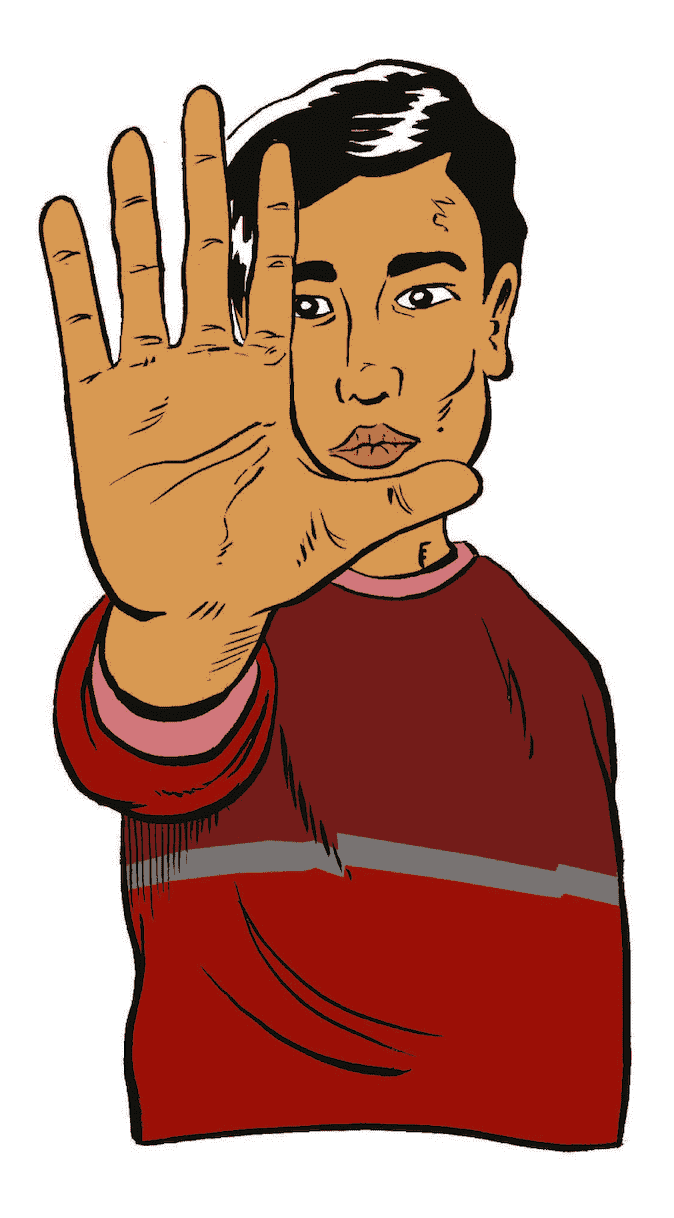RESEARCH BASED
SCIENTIFIC
“Ah-ha! moments”
According to the comics theorist, Scott McCloud, cartoons operate on the principle of “amplification through simplification” 1. By taking an image and simplifying it, stripping away its excess “baggage,” an artist can amplify its meaning. Research demonstrates that cartoon-images are powerful and efficient. A 2016 study by Kendall and colleagues 2 found that cartoon faces were 60% more accurately recognized than real faces. Moreover, the brains of the participants needed to work less hard to perceive the faces, when they saw them in cartoon-form. This explains the “Ah-ha!” moment of recognition that patients experience when they view the iModes for the first time.
Theoretically grounded
Modes are a central concept in Schema Therapy, an evidence-based therapy for personality disorders 3, 4. They are emotional states that, when triggered, dominate a person’s emotions, thoughts, and behaviors at a given moment. The iModes enhance patients’ ability to recognize and communicate about their emotional states (i.e., modes). Because they are a flexible and easy to grasp tool, therapists can integrate them into a variety of approaches (e.g., Cognitive Behavior Therapy, Acceptance and Commitment Therapy, Mindfulness, Gestalt, Client Centered, Psychodynamic Object Relations, and Creative Therapies).
Integrative in nature
The iModes tools incorporate concepts and approaches from Positive Psychology, the “science of positive human functioning and flourishing” 5. Dr. Bernstein created the The Qualities of the Healthy Adult Tool based on his own model of 16 human strengths divided into four broad dimensions: Self-Directedness, Self-Regulation, Connectedness, and Transcendence 6. The Emotional Needs Tool is based on Jeffrey Young’s theory of five universal emotional needs: Attachment, Autonomy, Empathy, Spontaneity and Play, and Safe Limits 3. The Healthy Adult Boat Tool is based on Hugo Alberts’s sailboat metaphor 7, which Dr. Bernstein adapted to depict phases of one’s life’s and integrated with the concepts of emotional needs, modes, and the four-dimensions of the Healthy Adult6.


EVIDENCE-BASED
iModes research
Our research shows that the iModes images are easily recognizable, and that people could use the cards to discover themselves 8. We showed the images to more than eight hundred people in two samples: university students and an internet sample seeking help for personality disorders. The great majority of people were able to recognize the meaning of the images correctly. Moreover, when asked to rate how highly the pictures applied to them, their responses were highly correlated with their mode scores, based on a reliable and valid questionnaire.
Proven easy to learn
In a recent study 9, police officers used the iModes to identify the emotional states of people they encountered at crime scenes. They just looked through the cards, and achieved a high level of proficiency in less than 30 minutes. Many professionals can start to use the cards immediately, with little or no training.
Effective with youth and adults
The iModes are suited for use with adults and children and youth aged 12 and older. They are widely used for youth treatment, including with adolescents in residential and forensic treatment, and with families seen by Child Protective Services. They have shown initial evidence of effectiveness in several studies, for example, in a recently published study of youth with serious behavior problems in residential care 10.
RESEARCH BASED
SCIENTIFIC
“Ah-ha! moments”
According to the comics theorist, Scott McCloud, cartoons operate on the principle of “amplification through simplification” 1. By taking an image and simplifying it, stripping away its excess “baggage,” an artist can amplify its meaning. Research demonstrates that cartoon-images are powerful and efficient. A 2016 study by Kendall and colleagues 2 found that cartoon faces were 60% more accurately recognized than real faces. Moreover, the brains of the participants needed to work less hard to perceive the faces, when they saw them in cartoon-form. This explains the “Ah-ha!” moment of recognition that patients experience when they view the iModes for the first time.
Theoretically grounded
Modes are a central concept in Schema Therapy, an evidence-based therapy for personality disorders 3, 4. They are emotional states that, when triggered, dominate a person’s emotions, thoughts, and behaviors at a given moment. The iModes enhance patients’ ability to recognize and communicate about their emotional states (i.e., modes). Because they are a flexible and easy to grasp tool, therapists can integrate them into a variety of approaches (e.g., Cognitive Behavior Therapy, Acceptance and Commitment Therapy, Mindfulness, Gestalt, Client Centered, Psychodynamic Object Relations, and Creative Therapies).
Integrative in nature
The iModes tools incorporate concepts and approaches from Positive Psychology, the “science of positive human functioning and flourishing” 5. Dr. Bernstein created the The Qualities of the Healthy Adult Tool based on his own model of 16 human strengths divided into four broad dimensions: Self-Directedness, Self-Regulation, Connectedness, and Transcendence 6. The Emotional Needs Tool is based on Jeffrey Young’s theory of five universal emotional needs: Attachment, Autonomy, Empathy, Spontaneity and Play, and Safe Limits 3. The Healthy Adult Boat Tool is based on Hugo Alberts’s sailboat metaphor 7, which Dr. Bernstein adapted to depict phases of one’s life’s and integrated with the concepts of emotional needs, modes, and the four-dimensions of the Healthy Adult6.

EVIDENCE-BASED
iModes research
Our research shows that the iModes images are easily recognizable, and that people could use the cards to discover themselves 8. We showed the images to more than eight hundred people in two samples: university students and an internet sample seeking help for personality disorders. The great majority of people were able to recognize the meaning of the images correctly. Moreover, when asked to rate how highly the pictures applied to them, their responses were highly correlated with their mode scores, based on a reliable and valid questionnaire.
Proven easy to learn
In a recent study 9, police officers used the iModes to identify the emotional states of people they encountered at crime scenes. They just looked through the cards, and achieved a high level of proficiency in less than 30 minutes. Many professionals can start to use the cards immediately, with little or no training.
Effective with youth and adults
The iModes are suited for use with adults and children and youth aged 12 and older. They are widely used for youth treatment, including with adolescents in residential and forensic treatment, and with families seen by Child Protective Services. They have shown initial evidence of effectiveness in several studies, for example, in a recently published study of youth with serious behavior problems in residential care 10.

IMODES STORE
Our iModes tools help patients break old patterns, utilize strengths, develop resilience, and experience greater wellbeing and fulfillment of core emotional needs. Visit the iModes store now and discover the complete iModes product line.
IMODES STORE
Our iModes tools help patients break old patterns, utilize strengths, develop resilience, and experience greater wellbeing and fulfillment of core emotional needs. Visit the iModes store now and discover the complete iModes product line.
REFERENCES
1 – McCloud, S. (1994), Understanding Comics: The Invisible Art. New York: Harper Collins & Kitchen Sink Press.
2 – Kendall, L.N., Raffaelli, Q., Kingstone, A., & Todd, R.M. (2016). Iconic faces are not real faces: enhanced emotion detection and altered neural processing as faces become more iconic. Cognitive Research: Principles and Implications, 1:19
3 – Young, J., Klosko, J., & Weishaar, M. (2003). Schema Therapy: A Practitioner’s Guide. New York: Guilford Press.
4 – Rafaeli, E., Bernstein, D., & Young, J. (2011). Schema Therapy: Distinctive Features. Routledge/Taylor & Francis Group.
5 – Seligman, M. E. P. (2011). Flourish: A visionary new understanding of happiness
and well-being. New York, NY, US: Free Press.
6 – Bernstein, D. (2020, in press). Building Strengths in Schema Therapy and Beyond. A Guide to Using iModes, the Complete System. Maastricht, The Netherlands. iModes Publications.
7 – Alberts, H.J.E.M. (2018). The Sailboat Metaphor. Retrieved from www.positivepsychology.com
8 – Bernstein, D., Broers, N., & Miquel Bleier, C. (in preparation). Initial validation of the Bernstein iModes, a pictorially-based method of assessing emotional states, in quasi-clinical and student samples.
9 – Deller-Wessels, L. & Bernstein, D. (in preparation). Emotional states encountered by law enforcement officers: An initial test of the schema mode concept in police actions.
10 – Van Wijk-Herbrink, M., Arntz, A., Broers, N., & Bernstein, D.P. (2019). A Schema Therapy based milieu in secure residential youth care: Effects on aggression, group climate, repressive staff interventions, and team functioning. Residential Treatment of Children & Youth.

